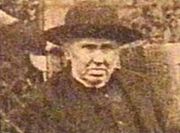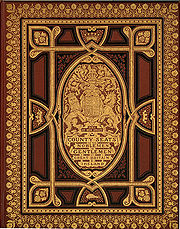
Benjamin Fawcett
Encyclopedia


Woodblock printing
Woodblock printing is a technique for printing text, images or patterns used widely throughout East Asia and originating in China in antiquity as a method of printing on textiles and later paper....
. The son of a ship's master, he was apprenticed at age 14 for seven years to William Forth, a Bridlington bookseller and printer. In 1831 he started his own business in Middle Street, Driffield
Driffield
Driffield, also known as Great Driffield, is a market town and civil parish in the East Riding of Yorkshire, England. The civil parish is formed by the town of Driffield and the village of Little Driffield....
, as music seller, bookbinder and printer, bookseller and stationer. He married Mary Ann Woodmansey in 1830, from whom he had two sons before her death in 1834. He was married again in 1848, to Martha Porter, and raised a large family of four daughters and six sons.
His early works were mostly children's books published by Webb & Millington of Leeds
Leeds
Leeds is a city and metropolitan borough in West Yorkshire, England. In 2001 Leeds' main urban subdivision had a population of 443,247, while the entire city has a population of 798,800 , making it the 30th-most populous city in the European Union.Leeds is the cultural, financial and commercial...
. In about 1845 he formed a close working association with Francis Orpen Morris
Francis Orpen Morris
Rev. Francis Orpen Morris , Irish ornithologist and entomologist, was notable as the author of many children's books and books on natural history and heritage buildings...
. This relationship would last nearly 50 years and have a profound effect on British ornithology. Morris wrote the text for books which were financed and printed by Fawcett, and were engraved by Alexander Francis Lydon
Alexander Francis Lydon
Alexander Francis Lydon was an English watercolour artist, illustrator and engraver of natural history and landscapes. He worked for Benjamin Fawcett the printer, to whom he had been apprenticed from an early age. He collaborated on a large number of works with the Rev...
(1836-1917), who had started his career as Fawcett's apprentice. Colour printing showed an enormous improvement over the work of Thomas Bewick
Thomas Bewick
Thomas Bewick was an English wood engraver and ornithologist.- Early life and apprenticeship :Bewick was born at Cherryburn House in the village of Mickley, in the parish of Ovingham, Northumberland, England, near Newcastle upon Tyne on 12 August 1753...
(1753-1828). At first wood-engraving illustrations were coloured by hand, but later a system of colouring from multiple wood blocks was used.
Hand-coloured wood engraving started with an accurate painting of the subject. This picture was then carved on a wooden block, standing proud in order to pick up the ink. The block was then placed in a printing press to give a black-and-white print, which was then hand-coloured. The wooden print blocks were carved with meticulous attention to detail. Pear and boxwood had the necessary qualities in that they were hard and fine-grained, making them durable and capable of showing fine detail. Most of their joint works were published by Groombridge, of London.
Fellow engraver, W.D. Ridley wrote:
"Benjamin Fawcett was undoubtedly a born genius in the best sense of the word; for in a remote country town in the early days of railway facilities, when it must have been difficult to buy high-grade colour inks, he brushed all difficulties aside, purchased his own boxwood shipped direct from Turkey, matured it, sawed it in slices, surfaced it accurately, drew the whole of his work, Morris's British Birds, upon these blocks himself, and with the aid of his clever wife, actually produced the first edition so far as the blocks were concerned, ...."
"If there was a secret which produced the fine results it would have been... Benjamin Fawcett engraving every one of the three hundred and sixty plates for this work on wood with his own hand ... making the inks himself from the costliest powders and the most expensive varnishes procurable....and each specimen plate for the colourers painted by his wife. This, I believe, is an achievement without parallel in book production. The very best materials were used."
Benjamin Fawcett died in January 1893, a few weeks before Francis Orpen Morris.
Selected books printed by Fawcett
- A Natural History of British Birds. The Rev. Francis Orpen Morris (1850-1857) 6 vols., 8vo, Groombridge.
- British Fresh-water Fishes. The Rev. William Houghton (Two volume set). Benjamin Fawcett [printer], A F Lydon [artwork], Publisher William Mackenzie: [1879]: London.
First Edition xxvi, 202pp (380 x 290 mm), Illustrated with 41 full page colour plates as well as vignette head pieces,
brick-red cloth, with piscatorial emblems. 41 tissue-guarded colour-printed xylograph plates by Benjamin Fawcett of Driffield after A.F.Lydon, and another 64 woodcuts by Lydon.
- Parrots in Captivity. William Greene.
- Alpine Plants. David Wooster.
- County Seats of The Noblemen and Gentlemen of Great Britain and Ireland. The Rev. Francis Orpen Morris (1870). William Mackenzie, Ludgate Hill.

